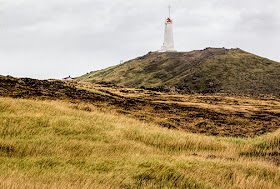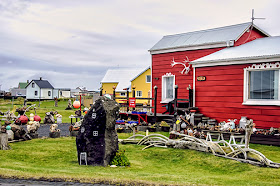 A fence made of lava boulders - this. I think, would be a neat project: to document the structures made of different materials - according to the available materials of the area.
A fence made of lava boulders - this. I think, would be a neat project: to document the structures made of different materials - according to the available materials of the area.
I am sure that it has already been done many times over, but still ....
 There is a smooth splash of different colour amongst the rocks. A small passerine - all wet and cold! It looks like we came over a Water Pipit, Anthus spinoletta, but do not take this for granted.
There is a smooth splash of different colour amongst the rocks. A small passerine - all wet and cold! It looks like we came over a Water Pipit, Anthus spinoletta, but do not take this for granted.
It was quite far and this is the best I could come up with for identification. It does have several cousins in the Pipit family - I am not sure if Water Pipit lives this far North. In any case, it was there, a pipit of sorts, and it made the wind and rain more bearable for us.
it was actually only a couple of kilometers away from this place: the steaming and stinky area of red and yellow iron and sulphur deposits. Primeval, warm and diverse in shapes and colours. Fascinating. My kind of a place!
There is a sad and frightening legend floating about the harsh lava fields. It a story of Gunna - a young, and beautiful girl.
They say that Gunna was a poor and could not pay her rent. This probably sounds familiar to many ... in any case a man of power came over to her and demanded the payment.
Since she could not pay, he took her only possession - a cooking pot.
(Hmmm.....what would a rich guy do with a cooking pot?
My feeling is that, seeing a beautiful young girl, he asked for more than that. )
They say that Gunna got really angry (who would'nt ? ) refusing to drink Holy Water.
A holy what????? Why? Com'on - this really sounds like a setup.
Who offered her that ?????
Soon they found her dead!
(Sounds like someone needed to cover their tracks.)
Well!
And the funeral: the bearers felt the coffin becoming lighter and lighter. Too many drinks to keep the cold at bay?
Then, in the squealing wind they heard: "No need to dig deep, no need to lie long."
They swore that this was Gunna talking! I am not convinced - in the howling winds we are experiencing (and probably having a drink or more ) one can hear MANY things.
Did someone help by spreading around a potent rumor?
The day after the funeral they found dead and badly beaten body nearby the village. It was the lawyer, who at the beginning of our story, confronted Gunna.
Remember the "cooking pot" ?
Well!
They all blamed it on Gunna's ghost but I am inclined to believe that a beautiful young girl had a boyfriend ... who guessed what happened and took his and Gunna's revenge.
Soon after others paid price as well (... who came up with an idea of holy water anyway?)
All blamed on Gunna's ghost!
Then someone came up with a suggestion of luring Gunna's ghost away.
Take a ball of yarn throw it in the hottest spring and have a lead thread coming out a long way. form there!
Was Gunna fond of knitting?
(Although I cannot fathom how, since she had nothing but a cooking pot, was she able to obtain any wool while she was alive ).
Anyway. The trick worked!
Gunna's resourceful ghost grabbed the lead, followed it to the hottest spring, and in order to reach the ball of wool, it had fallen into the scalding water to die the second time!
Com'on, a ghost would go for THAT?
The killings stopped.
As for you, boyfriend, that was some clever work, I thought, when reading Gunna's story while vicious wind and nauseous sulphuric gases were making my head spin.
No wonder they believed anything.
As you can see, I have this really strong feeling that an awful murder(s) happened here some three centuries ago. And I am walking away being totally on Gunna's side.
In any case, this is why the area we are to explore is called GUNNUHVER.

 Who said that photographing wind was difficult?
Just have a look at the two strong men barely standing up on their feet.
The jacket says it all.
Who said that photographing wind was difficult?
Just have a look at the two strong men barely standing up on their feet.
The jacket says it all.
A group of foreign tourists arrived by a tour bus; clad in their nice dresses and inappropriate footwear they jumped out, iPhones and point & shoots ready, they click-clicked their photos and ran back to the safety of the bus.
Probably one of the weekend tours doing the Iceland's famous Golden Circle Tour.
No need for explanation - just stay on the trail and try not to step elsewhere - the crust is fragile.
It is challenging to stay still with the wind howling at ones' back.
Yet, even on a day like this there are hundreds of shots one could take.
The problem is to figure out how to keep the lens from shaking while holding onto ones' hat and trying to have both feet planted firmly into the twitching platform.
If that's not multitasking, I do not know what is.
There in the background is one of many of Iceland's Geothermal Power Stations - I am not really sure of the name but it could be the Reykjanes Power Station.

 There is a trail leading to the coast and to the lighthouse there. But, once again, we are not going to explore that one today - and we are off to Grindavik.
There is a trail leading to the coast and to the lighthouse there. But, once again, we are not going to explore that one today - and we are off to Grindavik.







































































